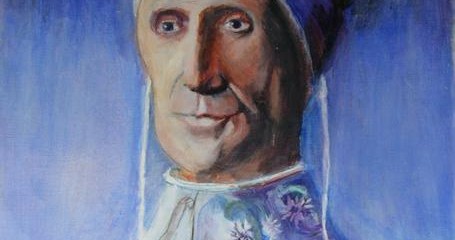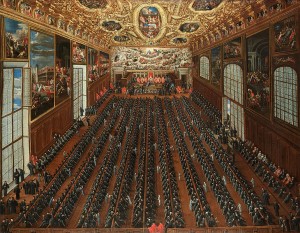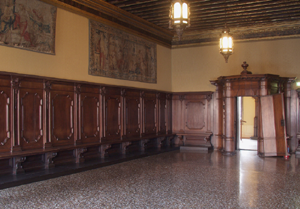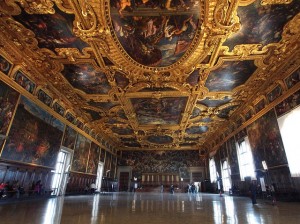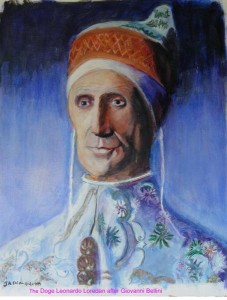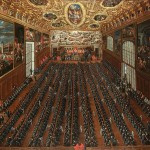The Council (il consiglio), a collegial body with consultative or deliberative functions, replaces the popular assemblies in Venice,forming the foundations of the Venetian constitution. The patrician of Venice, a branding member of the council is raised from childhood with the idea that everything he has is due to the Republic. He must use his intelligence and experience, for the good of the Republic. It is out of the law refusing a public commitment. Throughout his life, the individual is subordinate to the state. Private interests take a back seat. The first constitutional law of Venice, ending the reign of the dynasty of Orseoli . This law prohibits the head of the city to associate a co-regent to his power. The new sovereign was assisted by two counselors who watched his acts while assisting him. Later the number of councilors increased to six, thus springing the Minor Council.
The “Council of Ten”
The Hall of the “Council of Ten” was destined to the meetings of the eponymous organ, small and powerful, the guardian of the national security.
Composed after the conspiracy of Tiepolo (1310) the “Council of Ten”
was a special committee of ten members with the task of discovering and judge the acts of treason against the republic. At the beginning elected for a term of three months, this was extended each year until 1335 when it became the permanent council. The board met every day, receiving complaints, listening the reports of their spies, judging by the quick and secret procedure, crimes against state security.
They “watch” everything, from the diplomacy,administration, the Senate, the leaders of the ten,the doge.
The council were renewed every month to avoid bribes.
No complaint was received without being the subject of a carefull discussion .To spend a complaint it was needed four-fifths of the votes. The anonymous complaints were examined in an even more severe. The accused could cite witnesses and have lawyers. Before pronouncing the sentence, was made a second reading of the evidence. The communal lawyer needed more than half of the votes to propose the condemnation. The punnishment could be exile, condemned to the galleys, imprisonment in weights (pozzi) ,or in the pits (piombi), death by hanging, beheading or night drowning in the waters of the lagoon.
Spite of the fear instilled by the Council of Ten, the executions do not were on average more than ten a year.And despite all precautions, there were also errors.
Wellknown is the history of Fornaretto, or rather the “pòvaro Fornaretto”, as in general it is defined here in the city. Some say that his name was Pietro Faccioli, nicknamed “Fasiol” (bean), some, Peter Tasca. He worked in his father’s baker shop , in Calle della Mandola. One day in the spring of 1507, the fornaretto,coming down the steps of the Bridge of
Assassins, the wood bridge, no longer exists since the Rio was buried, (Rio Tera of Assassins), he found a dead man stabbed in the street and was blamed of murder. The machinery of justice is set in motion and the unfortunate young man was tortured.
The fornaretto, never admitted the fact committed. The inquisitors, decreed his death sentence by beheading , between the two columns of San Marco and San Todaro. Immediately after his beheading, a servant came running to stop the execution, shouting: “The fornaretto is innocent, the culprit confessed that had committed the murder devoured by jealousy.”
The voice of the servant who cried the innocence of Peter spread throughout Venice. The next day the Doge Leonardo Loredan, convened the Council of Ten and the entire
Venetian Judiciary , stating that before any judgment they should pronounce the sentence: “Recordève of pòvaro Fornaretto!” wich mean : Remember of the inocent Fornaretto. This phrase will be repeated until the end of the Venetian Republic, and will reflect the charge before issuing a sentence, repeating it three times.
Since then, two red candles are lit every night between two arches of the Basilica, in front of the point where were the scaffold, as perennial excuse of the city to the innocent victim.
The writer Francis dall’Ongaro wrote in 1848 a successful play entitled “The fornaretto of Venice.” Even in the cinema, there were played several versions , with a great success.
read the whole history http://venezia.myblog.it/2009/07/04/le-fiaccole-che-illuminano-la-giustizia-a-venezia/
the movie http://www.imdb.com/title/tt0057068/reviews-1
In the Ducal Palace, a symbol of the city of Venice, lived, the supreme head of the republic.Here gathered also the Councils, set up by the Venetian constitution.
In 1143, are elected in the various districts of the city,gli sapienti (the wise men) representing the Permanent Council of the Doge. Fifty years later, they become “wise men of the Minor Council.” Initially were appointed for one year and must give an oath called “promissio.”
The main hall of the doge’s palace, situated on the corner between the Molo and the Piazzetta, was once the seat of the highest judiciary in Venice, the Full Council.
The “Full Council”, founded as a popular assembly, becomes in time a meeting that brings together all the Venetian nobility. Has legislative power, prepares the laws of the republic and discuss them in the internal assemblies. May intervene in any public domain and has the power to appoint, through elections, all the offices of state.The Full Council vote all the judges, prosecutors, senators ,the “ten”, and the civil governors. Inside the Full Council are set up, many committees,and the most important, composed of forty persons will born the tribunal of the Forty (Quarantia,mentioned for the first time in the archives in 1223).
The Senate
The hall of the Senate, overlooking the Rio di Palazzo, is the place were the Council of Pregadi (or Senate) meets.
At the begining a temporary council,i pregati,(pregati = gently asked),those that are asked to be helpful in government affairs ,becomes with the passage of time an permanent council. It was the germine of the future Senate called “consiglio dei pregati” . The senate,find a final organization when the selection of the members will be entrusted to the Full Council.The number of members is fixed at sixty to which were added a number of sixty other officials elected under the name of ” Zonta “, added , that become permanent members after few years.
At this number of people were added : the Doge and his counselors, the procurators of St. Mark , the great wise men (i savii grandi), the judges of the Forty (i giudici della Quarantia),the leaders of key public services . All these members made the Senate bigger than three hundred persons.The Senate administered the finances ( public money , loans, taxes, etc.) and was in charge of public administration in both the city and the mainland and in the overseas possessions . It was always the senate to decide by the commanders of armies, generals , high-ranking officials and direct diplomacy to do wars or alliances .
In the Doge’s Palace, Sala del Collegio, communicating with the Senate hall,and was designed for meetings of the Board of Elders and the Venetian Signoria.
Il Collegio The board was composed of twenty-six members: ten of the lordship and sixteen wise men called “savii” : six “great wise men”an authoritative position occupied by the most senior officials and procurators of St. Mark; five “wise men from the mainland,” that dealt with the war ,finance , and directed the foreign policy and home affairs, and the other five “wise men orders”, in charge of things related to the sea, having in their hands the diplomatic archives, to be able to learn business and in order to cover positions in the state. The lordship (la signoria).
From 1423 replaces the common Veneciarum. In the absence of the Doge, presided over the full Council and the Senate, received the ambassadors. Twice a week were present at the Doge’s Palace to receive the complaints of the citizens of every class. It was composed by the Doge, his advisers and the three chiefs of the Forty (Quarantia).
other items: http://dipoco.altervista.org/see-other-items/
visit my website http://ginocosta.altervista.org/you-can-do-it.html
